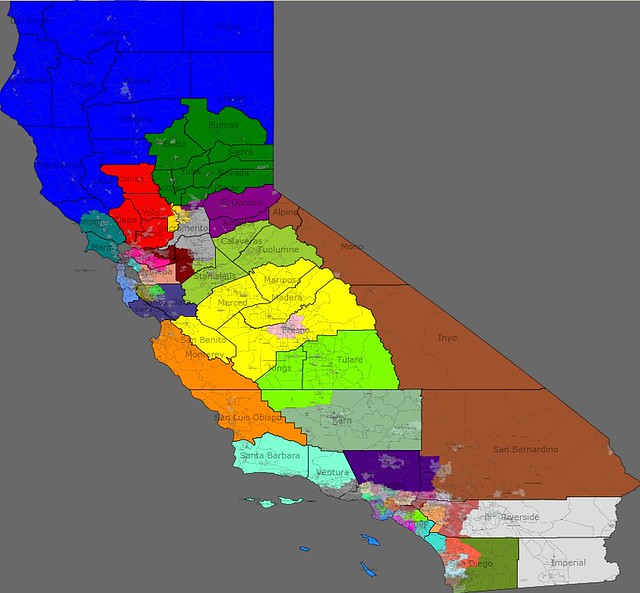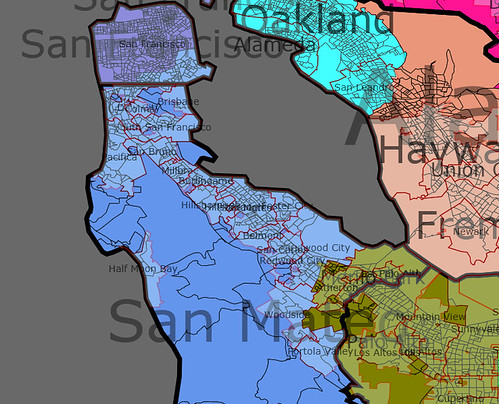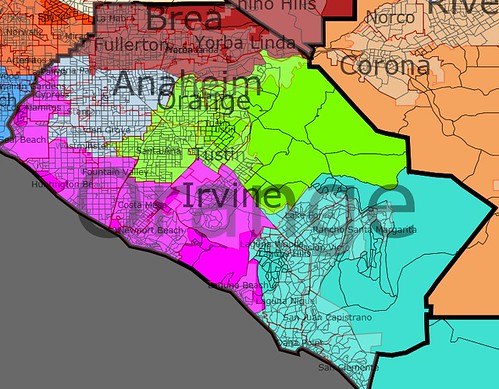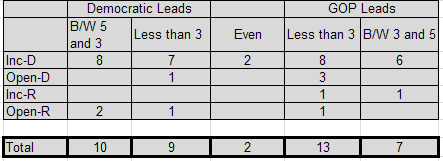Here is Part 3, the last part of my analysis of this fall’s elections in California, which will cover the state legislative races.
Cross-posted at Daily Kos, Calitics, and Democracy for California.
STATE SENATE (District size: ~846,791) (Composition: 25 Democrats, 15 Republicans)
Districts to watch:
SD-12 (Part of Central Valley and inland Central Coast): Ceres Mayor Anthony Cannella (R) vs. St. Asm. Anna Caballero (D) – vacated by Jeff Denham (R)
Registration: 50.2% DEM, 31.1% GOP, 14.9% DTS, 3.8% Other
Profile: In spite of the hefty registration advantage, Denham managed to win twice in this district because many Democrats here are more conservative than most California Democrats. Nonetheless, this is still the best (and only) opportunity for a Democratic pickup in the State Senate for the first time in a decade. Caballero also got more votes than Cannella in the primary (neither had primary challengers), even though Republican turnout was higher due to competitive statewide office primaries on that side and few on the Democratic side. If Caballero could get more votes even in spite of lower Democratic turnout (though I’m not sure what the numbers in the 12th were), then she probably will be able to do so again in the general, with higher Democratic turnout.
10/27/2010 Outlook: Toss-up/tilt Caballero (Dem pickup)
SD-34 (Central Orange County): Lou Correa (D) vs. Anaheim Councilwoman Lucille Kring (R)
Registration: 44.5% DEM, 32.4% GOP, 19.3% DTS, 3.8% Other
Profile: This was a close call in 2006, with Correa hanging on by just about a thousand or so votes. The registration gap was also much smaller, with Democrats having only a 39%-37% edge, and for those that may remember, turnout in 2006 was depressed due to bitterness in the governor’s race. Now, though, with a 12-point Dem registration advantage and turnout likely to improve over 2006, Correa’s prospects for a second term look brighter.
10/27/2010 Outlook: Likely Correa
Safe:
SD-01 (Sierras): Special election to replace the deceased Dave Cox (R)
SD-02 (North Coast): Noreen Evans (D) – vacated by Pat Wiggins (D)
SD-04 (Sacramento Valley and Del Norte County): Doug LaMalfa (R) – vacated by Sam Aanestad (R)
SD-06 (Sacramento): Darrell Steinberg (D)
SD-08 (San Mateo, western part of San Francisco): Leland Yee (D)
SD-10 (Southern Alameda County, northern Santa Clara County): Ellen Corbett (D)
SD-14 (San Joaquin, Yosemite, eastern Fresno): Tom Berryhill (R) – vacated by Dave Cogdill (R)
SD-16 (Central Valley including parts of Fresno and Bakersfield): Michael Rubio (D) – vacated by Dean Florez (D)
SD-18 (Bakersfield, Tulare, Big Empty): Jean Fuller (R) – vacated by Roy Ashburn (R)
SD-20 (San Fernando): Alex Padilla (D)
SD-22 (South Pasadena, part of L.A.): Kevin de León (D) – vacated by Gil Cedillo (D)
SD-24 (Covina, Baldwin Park, part of L.A.): Ed Hernandez (D) – vacated by Gloria Romero (D)
SD-26 (Culver City): Curren Price (D)
SD-28 (Beach Cities): Vacant (Jenny Oropeza (D) died October 20, 2010. If she “wins”, a special will be held)
SD-30 (Eastern L.A. suburbs): Ron Calderon (D)
SD-32 (Pomona, San Bernardino): Gloria Negrete-McLeod (D)
SD-36 (Eastern San Diego County): Joel Anderson (R) – vacated by Dennis Hollingsworth (R)
SD-38 (San Juan Capistrano, Oceanside, Carlsbad): Mark Wyland (R)
SD-40 (Imperial County, southeastern Riverside and San Diego Counties): Juan Vargas (D) – vacated by Denise Ducheny (D)
STATE ASSEMBLY (District size: ~423,388) (Composition: 50 Democrats, 29 Republicans, 1 Independent)
Districts to watch:
AD-05 (Northern Sacramento suburbs): Businessman Andy Pugno (R) vs. Dr. Richard Pan (D), Elizabeth Martin (PF) – vacated by Roger Niello (R)
Registration: 40.1% GOP, 37.7% DEM, 17.9% DTS, 4.3% Other
Profile: In this evenly-divided district just outside Sacramento, we have a very formidable candidate in Pan against Prop. 8 author Pugno. This district overlaps the 3rd congressional district and will likely see a lot of activity.
10/27/2010 Outlook: Toss-Up
AD-10 (Eastern Sacramento suburbs): Alyson Huber (D) vs. businessman Jack Sieglock (R), Janice Bonser (L), Albert Troyer (PF)
Registration: 40.9% DEM, 39.1% GOP, 16.1% DTS, 4.0% Other
Profile: In another evenly-divided Sacto-area seat that also happens to partly overlap CA-03, we have another exciting race, where in 2008 Huber won by under 500 votes and was declared the winner after her opponent went to the capital for orientation. He is back for a second round, and while Huber doesn’t have coattails working in her favor, she does have incumbency (no incumbent in the state legislature has lost reelection in a decade) and a Democratic trend in registration on her side.
10/27/2010 Outlook: Toss-Up/tilt Huber
AD-15 (Inner East Bay): Joan Buchanan (D) vs. San Ramon Mayor Abram Wilson (R)
Registration: 41.5% DEM, 35.3% GOP, 19.3% DTS, 3.9% Other
Profile: This district includes parts of San Joaquin County and conservative parts of Contra Costa and Alameda Counties, much of which overlaps the hotly-contested CA-11 race. Buchanan ran in the CA-10 special election last year, so that may be a liability for her, but she is still favored to win because of an increasing Dem advantage in registration, incumbency, and the fact that rematches rarely succeed for the challenger.
10/27/2010 Outlook: Tilt/Lean Buchanan
AD-30 (Southern San Joaquin Valley): Farmer David Valadao (R) vs. businesswoman Fran Florez (D) – vacated by Danny Gilmore (R)
Registration: 45.7% DEM, 36.1% GOP, 14.3% DTS, 3.9% Other
Profile: This was the only legislative gain for the GOP in 2008 because the outgoing Democrat Nicole Parra endorsed Gilmore. This time Gilmore is not running, while Florez is again, having defeated Nicole Parra’s father Pete in the primary. Parra endorsed Valadao, plus a poll has shown him with a double-digit lead, so I’ll leave it as a retention for Team Red.
10/27/2010 Outlook: Lean Valadao
AD-33 (Part of southern Central Coast): SLO County Sup. Katcho Achadjian (R) vs. Santa Maria Mayor Pro Tem Hilda Zacarias and Paul Polson (L) – Vacant; Sam Blakeslee (R) was elected to the State Senate
Registration: 40.6% GOP, 35.4% DEM, 18.4% DTS, 5.6% Other
Profile: In this open seat on the Central Coast, we have another formidable Democratic challenger. The registration gap does make things a little challenging for us here, but from what I heard Hilda has had a strong ground campaign.
10/27/2010 Outlook: Lean Achadjian
AD-36 (Lancaster, Palmdale): Steve Knight (R) vs. school board member Linda Jones (D)
Registration: 39.1% GOP, 38.6% DEM, 17.0% DTS, 5.2% Other
Profile: This race was closer than expected in 2008 due to presidential coattails and many minorities moving into the Antelope Valley area. This time around, though, the lack of coattails and incumbency will make this race less competitive than last time.
10/27/2010 Outlook: Lean to Likely Knight
AD-68 (Garden Grove, Costa Mesa): (D) – Costa Mesa Mayor Allan Mansoor (R) vs. entrepreneur Phu Nguyen – vacated by Van Tran (R)
Registration: 41.0% GOP, 32.4% DEM, 22.0% DTS, 4.6% Other
Profile: Here is another strong candidate we have in Nguyen, who has the backing of public safety unions (even though Mansoor is a former deputy) and has led in campaign spending and cash-on-hand. While this is a very traditionally Republican area that has long been a tough nut for Democrats to crack, look for this to be the closest a Democrat has come to winning in this area in a long time if Nguyen can rally the Vietnamese and Hispanic communities in the district.
10/27/2010 Outlook: Lean Mansoor
AD-70 (Irvine, Laguna Beach): CC Trustee Don Wagner (R) vs. attorney Melissa Fox (D) and Deborah Tharp (L) – vacated by Chuck DeVore (R)
Registration: 43.0% GOP, 29.8% DEM, 23.2% DTS, 4.0% Other
Profile: In another OC district, Democrat Fox is mounting a strong, serious challenge, and Democrats are becoming more competitive here because of the bluing of Irvine (going from Bush by 8 in 2000 to Bush by 5 in 2004 to Obama by 16 in 2008).
10/27/2010 Outlook: Lean to Likely Wagner
Safe:
AD-01 (North Coast): Wesley Chesbro (D)
AD-02 (Sacramento Valley): Jim Nielsen (R)
AD-03 (Northeast): Dan Logue (R)
AD-04 (Tahoe): Ted Gaines (R)
AD-06 (North Bay): Jared Huffman (D)
AD-07 (Napa Valley): Michael Allen (D) – vacated by Noreen Evans (D)
AD-08 (Sacramento River Delta): Mariko Yamada (D)
AD-09 (Sacramento): Roger Dickinson (D) – vacated by Dave Jones (D)
AD-11 (Northern Contra Costa County): Susan Bonilla (D) – vacated by Tom Torlakson (D)
AD-12 (Western San Francisco): Fiona Ma (D)
AD-13 (Eastern San Francisco): Tom Ammiano (D)
AD-14 (Berkeley, Richmond): Nancy Skinner (D)
AD-16 (Oakland): Sandré Swanson (D)
AD-17 (Stockton, Merced): Cathleen Galgiani (D)
AD-18 (Eastern Oakland suburbs): Mary Hayashi (D)
AD-19 (Most of San Mateo County): Jerry Hill (D)
AD-20 (Southern East Bay): Bob Wieckowski (D) – vacated by Alberto Torrico (D)
AD-21 (Silicon Valley): Rich Gordon (D) – vacated by Ira Ruskin (D)
AD-22 (Western San Jose): Paul Fong (D)
AD-23 (Downtown San Jose): Nora Campos (D) – vacated by Joe Coto (D)
AD-24 (Southern San Jose): Jim Beall (D)
AD-25 (Mother Lode, Yosemite): Kristin Olsen (R) (unopposed) – vacated by Tom Berryhill (R)
AD-26 (Stockton, Modesto): Bill Berryhill (R)
AD-27 (Northern Central Coast): Bill Monning (D)
AD-28 (Inner Central Coast region): Luis Alejo (D) – vacated by Anna Caballero (D)
AD-29 (Eastern Fresno): Linda Halderman (R) – vacated by Michael Villines (R)
AD-31 (Western Fresno): Henry Perea (D) – vacated by Juan Arambula (I)
AD-32 (Bakersfield): Shannon Grove (R) – vacated by Jean Fuller (R)
AD-34 (Big Empty): Connie Conway (R)
AD-35 (Santa Barbara, Oxnard): Das Williams (D) – vacated by Pedro Nava (D)
AD-37 (Most of Ventura, small part of L.A.): Jeff Gorell (R) – vacated by Audra Strickland (R)
AD-38 (Santa Clarita): Cameron Smyth (R)
AD-39 (San Fernando): Felipe Fuentes (D)
AD-40 (San Fernando Valley, including Van Nuys): Bob Blumenfield (D)
AD-41 (Oxnard, Malibu, Santa Monica): Julia Brownley (D)
AD-42 (Beverly Hills, West Hollywood): Mike Feuer (D)
AD-43 (Burbank, Glendale): Mike Gatto (D)
AD-44 (Pasadena): Anthony Portantino (D)
AD-45 (East L.A.): Gil Cedillo (D) – vacated by Kevin de León (D)
AD-46 (East L.A., Huntington Park): John Pérez (D)
AD-47 (Culver City): Holly Mitchell (D) – vacated by Karen Bass (D)
AD-48 (Part of South Central L.A.): Mike Davis (D)
AD-49 (Inner Northeastern suburbs of L.A.): Mike Eng (D)
AD-50 (Bellflower): Ricardo Lara (D) – vacated by Hector De La Torre (D)
AD-51 (Inglewood, Hawthorne): Steven Bradford (D)
AD-52 (Compton): Isadore Hall (D)
AD-53 (Beach Cities): Betsy Butler (D) – vacated by Ted Lieu (D)
AD-54 (Palos Verdes, Long Beach, Avalon): Bonnie Lowenthal (D)
AD-55 (Carson, Long Beach): Warren Furutani (D)
AD-56 (Norwalk, Buena Park): Tony Mendoza (D)
AD-57 (Covina, Baldwin Park): Roger Hernandez (D) – vacated by Ed Hernandez (D)
AD-58 (Inner Eastern suburbs of L.A.): Charles Calderon (D)
AD-59 (Parts of L.A. and San Bernardino Counties): Tim Donnelly (R) – vacated by Anthony Adams (R)
AD-60 (Western Inland Empire): Curt Hagman (R)
AD-61 (Pomona, Ontario): Norma Torres (D)
AD-62 (San Bernardino, Fontana): Wilmer Carter (D)
AD-63 (Rancho Cucamonga, Redlands): Mike Morrell – Vacant; Bill Emmerson (R) was elected to the State Senate
AD-64 (Riverside, Palm Desert): Brian Nestande (R)
AD-65 (Yucca Valley, Big Bear): Paul Cook (R)
AD-66 (Temecula, Riverside): Kevin Jeffries (R)
AD-67 (Huntington Beach): Jim Silva (R)
AD-69 (Anaheim, Santa Ana): Jose Solorio (D)
AD-71 (Corona, part of inland Orange County): Jeff Miller (R)
AD-72 (Inland Northern Orange County): Chris Norby (R)
AD-73 (San Clemente, Oceanside): Diane Harkey (R)
AD-74 (Coastal Northern San Diego suburbs): Martin Garrick (R)
AD-75 (Inner Northern San Diego suburbs): Nathan Fletcher (R)
AD-76 (Northern San Diego City): Toni Atkins (D) – vacated by Lori Saldaña (D)
AD-77 (Most of inland San Diego County): Brian Jones (R) – vacated by Joel Anderson (R)
AD-78 (Chula Vista, Lemon Grove): Marty Block (D)
AD-79 (Southern San Diego City, Imperial Beach): Ben Hueso (D) – vacated by Mary Salas (D)
AD-80 (Imperial County, eastern Riverside County): Manuel Perez





